Top of the Atmosphere Reflected Shortwave Radiative Fluxes from ABI on GOES-18
Abstract
1. Introduction
2. Approach
2.1. Methodology
2.2. Data Used
- ABI L2 Clear Sky Mask (example file name: OR_ABI-L2-ACMC-M6_G18_s20223291901176_e20223291903549_c20223291905088.nc)
- ABI L2 Cloud Top Phase (example file name: OR_ABI-L2-ACTPC-M6_G18_s20223291901176_e20223291903549_c20223291905408.nc)
- ABI L2 Cloud Optical Depth at 640 nm (example file name: OR_ABI-L2-CODC-M6_G18_s20223291901176_e20223291903549_c20223291907099.nc)
2.3. Matching Observations Between ABI/GOES-18 and CERES SSF
2.4. Averaging ABI Data to Match the CERES Pixel
2.5. Experiments with New ADMs
2.5.1. Experiment 1
2.5.2. Experiment 2
2.5.3. Experiment 3
3. Results
3.1. Results for January, April, and July After Removing Outliers
3.2. Investigation of the July Case
- (a)
- Matchup between ABI and CERES swaths. Red pixels are CERES FOVs.
- (b)
- ABI flux image in 2 km resolution matched to CERES swath.
- (c)
- ABI flux image re-gridded to CERES resolution. Matched to CERES swath.
- (d)
- CERES flux image.
- (e)
- Density scatter plot between CERES and ABI.
- (f)
- Histogram and statistics.
- (g)
- ABI cloud fraction.
- (h)
- ABI 640 nm cloud optical depth.
4. Discussion and Summary
Author Contributions
Funding
Institutional Review Board Statement
Informed Consent Statement
Data Availability Statement
Acknowledgments
Conflicts of Interest
Appendix A
- OR_ABI-L1b-RadC-M6C06_G18_s20223272006173_e20223272008552_c20223272008583.nc
- OR_ABI-L1b-RadC-M6C06_G18_s20223272011173_e20223272013552_c20223272013586.nc
- OR_ABI-L1b-RadC-M6C06_G18_s20223272146173_e20223272148552_c20223272148582.nc
- OR_ABI-L1b-RadC-M6C06_G18_s20223272151173_e20223272153552_c20223272153585.nc
- OR_ABI-L1b-RadC-M6C06_G18_s20223282051175_e20223282053553_c20223282053582.nc
- OR_ABI-L1b-RadC-M6C06_G18_s20223291956176_e20223291958555_c20223291958581.nc
- OR_ABI-L1b-RadC-M6C06_G18_s20223292131176_e20223292133555_c20223292133582.nc
- OR_ABI-L1b-RadC-M6C06_G18_s20223292136176_e20223292138555_c20223292138586.nc
- OR_ABI-L1b-RadC-M6C06_G18_s20223302036177_e20223302038557_c20223302038587.nc
- OR_ABI-L1b-RadC-M6C06_G18_s20223302041177_e20223302043556_c20223302043588.nc
- OR_ABI-L1b-RadC-M6C06_G18_s20223311941179_e20223311943558_c20223311943588.nc
- OR_ABI-L1b-RadC-M6C06_G18_s20223312121179_e20223312123558_c20223312123597.nc
- OR_ABI-L1b-RadC-M6C06_G18_s20223322021170_e20223322023549_c20223322023584.nc
- OR_ABI-L1b-RadC-M6C06_G18_s20223322026170_e20223322028549_c20223322028580.nc
- OR_ABI-L1b-RadC-M6C06_G18_s20223332106172_e20223332108550_c20223332108584.nc
- OR_ABI-L1b-RadC-M6C06_G18_s20223332111172_e20223332113550_c20223332113584.nc
- OR_ABI-L1b-RadC-M6C06_G18_s20223342011173_e20223342013552_c20223342013580.nc
- OR_ABI-L1b-RadC-M6C06_G18_s20223342016173_e20223342018552_c20223342018579.nc
- OR_ABI-L1b-RadC-M6C06_G18_s20223342151173_e20223342153552_c20223342153580.nc
- OR_ABI-L1b-RadC-M6C06_G18_s20223352051175_e20223352053553_c20223352053580.nc
- OR_ABI-L1b-RadC-M6C06_G18_s20223352056175_e20223352058553_c20223352058589.nc
- OR_ABI-L1b-RadC-M6C06_G18_s20223271801173_e20223271803552_c20223271803580.nc
- OR_ABI-L1b-RadC-M6C06_G18_s20223271806173_e20223271808551_c20223271808582.nc
- OR_ABI-L1b-RadC-M6C06_G18_s20223271941173_e20223271943552_c20223271943579.nc
- OR_ABI-L1b-RadC-M6C06_G18_s20223271946173_e20223271948552_c20223271948584.nc
- OR_ABI-L1b-RadC-M6C06_G18_s20223272121173_e20223272123552_c20223272123582.nc
- OR_ABI-L1b-RadC-M6C06_G18_s20223281706174_e20223281708553_c20223281708583.nc
- OR_ABI-L1b-RadC-M6C06_G18_s20223281841174_e20223281843553_c20223281843585.nc
- OR_ABI-L1b-RadC-M6C06_G18_s20223281846174_e20223281848553_c20223281848583.nc
- OR_ABI-L1b-RadC-M6C06_G18_s20223282021174_e20223282023553_c20223282023582.nc
- OR_ABI-L1b-RadC-M6C06_G18_s20223282026174_e20223282028553_c20223282028584.nc
- OR_ABI-L1b-RadC-M6C06_G18_s20223291746176_e20223291748554_c20223291748590.nc
- OR_ABI-L1b-RadC-M6C06_G18_s20223291751176_e20223291753554_c20223291753582.nc
- OR_ABI-L1b-RadC-M6C06_G18_s20223291926176_e20223291928555_c20223291928589.nc
- OR_ABI-L1b-RadC-M6C06_G18_s20223292101176_e20223292103555_c20223292103582.nc
- OR_ABI-L1b-RadC-M6C06_G18_s20223292106176_e20223292108555_c20223292108587.nc
- OR_ABI-L1b-RadC-M6C06_G18_s20223301651177_e20223301653556_c20223301653585.nc
- OR_ABI-L1b-RadC-M6C06_G18_s20223301826177_e20223301828556_c20223301828588.nc
- OR_ABI-L1b-RadC-M6C06_G18_s20223301831177_e20223301833556_c20223301833589.nc
- OR_ABI-L1b-RadC-M6C06_G18_s20223302006177_e20223302008556_c20223302008589.nc
- OR_ABI-L1b-RadC-M6C06_G18_s20223302011177_e20223302013556_c20223302013584.nc
- OR_ABI-L1b-RadC-M6C06_G18_s20223302146178_e20223302148556_c20223302148587.nc
- OR_ABI-L1b-RadC-M6C06_G18_s20223311731179_e20223311733557_c20223311733589.nc
- OR_ABI-L1b-RadC-M6C06_G18_s20223311736179_e20223311738557_c20223311738584.nc
- OR_ABI-L1b-RadC-M6C06_G18_s20223311911179_e20223311913558_c20223311913585.nc
- OR_ABI-L1b-RadC-M6C06_G18_s20223312046179_e20223312048558_c20223312048589.nc
- OR_ABI-L1b-RadC-M6C06_G18_s20223312051179_e20223312053558_c20223312053589.nc
- OR_ABI-L1b-RadC-M6C06_G18_s20223321811170_e20223321813549_c20223321813577.nc
- OR_ABI-L1b-RadC-M6C06_G18_s20223321816170_e20223321818549_c20223321818578.nc
- OR_ABI-L1b-RadC-M6C06_G18_s20223321951170_e20223321953549_c20223321953577.nc
- OR_ABI-L1b-RadC-M6C06_G18_s20223321956170_e20223321958549_c20223321958577.nc
- OR_ABI-L1b-RadC-M6C06_G18_s20223322131170_e20223322133549_c20223322133579.nc
- OR_ABI-L1b-RadC-M6C06_G18_s20223331716171_e20223331718550_c20223331718578.nc
- OR_ABI-L1b-RadC-M6C06_G18_s20223331851171_e20223331853550_c20223331853583.nc
- OR_ABI-L1b-RadC-M6C06_G18_s20223331856171_e20223331858550_c20223331858583.nc
- OR_ABI-L1b-RadC-M6C06_G18_s20223332031172_e20223332033550_c20223332033577.nc
- OR_ABI-L1b-RadC-M6C06_G18_s20223332036172_e20223332038550_c20223332038587.nc
- OR_ABI-L1b-RadC-M6C06_G18_s20223341756173_e20223341758552_c20223341758585.nc
- OR_ABI-L1b-RadC-M6C06_G18_s20223341801173_e20223341803552_c20223341803580.nc
- OR_ABI-L1b-RadC-M6C06_G18_s20223341936173_e20223341938552_c20223341938579.nc
- OR_ABI-L1b-RadC-M6C06_G18_s20223342111173_e20223342113552_c20223342113582.nc
- OR_ABI-L1b-RadC-M6C06_G18_s20223342116173_e20223342118552_c20223342118581.nc
- OR_ABI-L1b-RadC-M6C06_G18_s20223351701174_e20223351703553_c20223351703586.nc
- OR_ABI-L1b-RadC-M6C06_G18_s20223351836174_e20223351838553_c20223351838580.nc
- OR_ABI-L1b-RadC-M6C06_G18_s20223351841175_e20223351843554_c20223351843586.nc
- OR_ABI-L1b-RadC-M6C06_G18_s20223352016175_e20223352018554_c20223352018580.nc
- OR_ABI-L1b-RadC-M6C06_G18_s20223352021175_e20223352023554_c20223352023584.nc
- OR_ABI-L1b-RadC-M6C06_G18_s20223352156175_e20223352158553_c20223352158580.nc
Appendix B
| Bias | Stdev | Rmserr | Pbias * | Pstdev | Prmserr | Corr | NumData |
| 3.8665 | 20.023 | 20.392 | 2.1135 | 10.945 | 11.147 | 0.97073 | 10,736 |
| 0.66149 | 25.874 | 25.882 | 0.26728 | 10.455 | 10.458 | 0.97706 | 15,389 |
| 13.266 | 24.652 | 27.994 | 5.9367 | 11.033 | 12.528 | 0.96986 | 10,644 |
| −0.53501 | 21.891 | 21.89 | −0.31999 | 13.093 | 13.092 | 0.9283 | 1592 |
| 7.088 | 22.141 | 23.247 | 4.1478 | 12.957 | 13.604 | 0.9621 | 11,053 |
| 1.378 | 28.691 | 28.723 | 0.54275 | 11.301 | 11.313 | 0.97016 | 13,124 |
| 7.5962 | 23.211 | 24.421 | 4.7738 | 14.587 | 15.347 | 0.9353 | 8926 |
| 3.5306 | 23.2 | 23.466 | 1.5227 | 10.006 | 10.121 | 0.97869 | 12,905 |
| 3.5935 | 24.836 | 25.094 | 1.3817 | 9.5491 | 9.6481 | 0.93414 | 10,361 |
| 5.363 | 21.875 | 22.501 | 3.0321 | 12.368 | 12.722 | 0.94749 | 493 |
| 9.8109 | 21.25 | 23.404 | 5.4299 | 11.761 | 12.953 | 0.97128 | 12,210 |
| 3.0912 | 24.991 | 25.181 | 1.2734 | 10.295 | 10.373 | 0.9765 | 14,579 |
| 18.171 | 24.574 | 30.561 | 8.6588 | 11.71 | 14.563 | 0.94386 | 6959 |
| 5.3917 | 20.167 | 20.873 | 3.0222 | 11.304 | 11.7 | 0.96624 | 5894 |
| 4.3986 | 22.803 | 23.222 | 2.0014 | 10.376 | 10.567 | 0.96909 | 14,425 |
| 9.6256 | 25.682 | 27.426 | 5.2812 | 14.091 | 15.047 | 0.94523 | 11,865 |
| 1.9931 | 19.538 | 19.639 | 0.91657 | 8.9853 | 9.0315 | 0.97588 | 12,435 |
| 8.0248 | 23.321 | 24.663 | 4.0998 | 11.915 | 12.6 | 0.96751 | 15,972 |
| 15.85 | 29.27 | 33.285 | 6.8968 | 12.736 | 14.483 | 0.95024 | 9389 |
| −1.1858 | 19.972 | 20.004 | −0.59152 | 9.9625 | 9.9782 | 0.96977 | 2702 |
| 2.7987 | 21.966 | 22.142 | 1.308 | 10.266 | 10.349 | 0.9642 | 11,821 |
| 6.709 | 27.933 | 28.726 | 3.249 | 13.527 | 13.911 | 0.95984 | 13,719 |
| −1.4283 | 24.971 | 25.011 | −0.68708 | 12.012 | 12.031 | 0.95672 | 11,423 |
| 1.8815 | 24.834 | 24.904 | 0.83653 | 11.041 | 11.072 | 0.97528 | 13,546 |
| 14.489 | 19.634 | 24.401 | 6.719 | 9.1049 | 11.315 | 0.955 | 10,249 |
| 5.0631 | 22.694 | 23.242 | 2.7102 | 12.147 | 12.441 | 0.92892 | 1113 |
| 7.2967 | 25.276 | 26.307 | 3.0413 | 10.535 | 10.965 | 0.97109 | 13,281 |
| 1.5643 | 25.267 | 25.315 | 0.78965 | 12.755 | 12.779 | 0.97055 | 13,753 |
| −1.9913 | 31.033 | 31.094 | −0.6868 | 10.703 | 10.724 | 0.9324 | 5754 |
| * pbias is % bias. |
Appendix C
| Bias | Stdev | Rmserr | Pbias | Pstdev | Prmserr | Corr | NumData |
|---|---|---|---|---|---|---|---|
| 13.104 | 29.747 | 32.494 | 5.3286 | 12.097 | 13.214 | 0.94696 | 1180 |
| 0.45773 | 25.309 | 25.312 | 0.21162 | 11.701 | 11.702 | 0.97217 | 8985 |
| −2.5804 | 20.551 | 20.711 | −1.1447 | 9.1168 | 9.1878 | 0.97769 | 7144 |
| −4.1269 | 23.16 | 23.524 | −1.759 | 9.8712 | 10.026 | 0.96675 | 10,551 |
| −5.2965 | 23.058 | 23.655 | −2.774 | 12.076 | 12.389 | 0.95631 | 4329 |
| 2.6288 | 24.095 | 24.237 | 1.1277 | 10.336 | 10.397 | 0.97184 | 10,821 |
| −2.1375 | 24.945 | 25.03 | −1.0851 | 12.663 | 12.706 | 0.94767 | 2098 |
| −1.3178 | 25.055 | 25.089 | −0.5938 | 11.29 | 11.305 | 0.96471 | 9238 |
| −0.66777 | 23.447 | 23.455 | −0.3612 | 12.683 | 12.687 | 0.95339 | 9461 |
| 4.6342 | 22.732 | 23.199 | 2.1959 | 10.772 | 10.993 | 0.97086 | 11,502 |
| 4.0747 | 24.06 | 24.401 | 1.937 | 11.438 | 11.599 | 0.96973 | 5364 |
| 1.689 | 23.421 | 23.481 | 0.75099 | 10.414 | 10.44 | 0.97376 | 12,566 |
| 3.2493 | 23.902 | 24.118 | 1.5377 | 11.312 | 11.414 | 0.96506 | 3170 |
| 6.1204 | 25.909 | 26.62 | 2.5249 | 10.688 | 10.982 | 0.97358 | 8994 |
| 1.7406 | 24.585 | 24.645 | 0.89419 | 12.63 | 12.661 | 0.94372 | 8858 |
| 12.101 | 23.417 | 26.35 | 5.6804 | 10.992 | 12.369 | 0.95341 | 1183 |
| 6.3615 | 22.22 | 23.112 | 2.9713 | 10.378 | 10.795 | 0.97387 | 11,787 |
| 10.007 | 24.525 | 26.487 | 4.2734 | 10.473 | 11.311 | 0.96856 | 14,155 |
| 12.29 | 27.712 | 30.282 | 5.1862 | 11.694 | 12.778 | 0.91189 | 385 |
| −0.032878 | 23.466 | 23.465 | −0.012176 | 8.6902 | 8.6898 | 0.9728 | 10,250 |
| 5.564 | 24.483 | 25.104 | 1.8739 | 8.2457 | 8.4549 | 0.9623 | 3968 |
| 0.6974 | 19.425 | 19.436 | 0.30349 | 8.4531 | 8.4582 | 0.98226 | 10,953 |
| −0.47176 | 23.426 | 23.426 | −0.19619 | 9.7419 | 9.7417 | 0.9675 | 2241 |
| −0.69884 | 25.326 | 25.334 | −0.32141 | 11.648 | 11.652 | 0.96292 | 11,247 |
| −4.4586 | 23.092 | 23.518 | −2.0541 | 10.639 | 10.835 | 0.96674 | 9932 |
| 7.7451 | 26.655 | 27.743 | 3.376 | 11.619 | 12.093 | 0.95598 | 866 |
| −1.74 | 24.196 | 24.257 | −0.84576 | 11.761 | 11.791 | 0.97138 | 11,245 |
| −6.7573 | 18.636 | 19.821 | −3.325 | 9.1698 | 9.7532 | 0.97581 | 5812 |
| 0.32497 | 19.679 | 19.681 | 0.15 | 9.0839 | 9.0848 | 0.98479 | 12,741 |
| −2.1467 | 23.768 | 23.861 | −0.87605 | 9.6994 | 9.7376 | 0.96599 | 3622 |
| −2.6019 | 21.027 | 21.186 | −1.242 | 10.037 | 10.113 | 0.97631 | 9266 |
| −0.099278 | 22.266 | 22.26 | −0.042418 | 9.5136 | 9.511 | 0.9634 | 1760 |
| 7.7764 | 19.779 | 21.251 | 3.9528 | 10.054 | 10.802 | 0.98055 | 8305 |
| 1.3074 | 22.653 | 22.69 | 0.55848 | 9.6771 | 9.6926 | 0.97328 | 8123 |
| 1.8388 | 21.974 | 22.049 | 0.81621 | 9.7535 | 9.7871 | 0.98052 | 10,360 |
| −0.21369 | 26.299 | 26.298 | −0.082323 | 10.131 | 10.131 | 0.96942 | 5477 |
| −10.653 | 24.022 | 26.277 | −4.473 | 10.087 | 11.033 | 0.97197 | 11,298 |
| −7.7988 | 26.764 | 27.872 | −3.061 | 10.505 | 10.94 | 0.94241 | 2586 |
| −0.24185 | 27.161 | 27.16 | −0.12118 | 13.609 | 13.609 | 0.96506 | 8660 |
| −5.387 | 24.828 | 25.405 | −2.2953 | 10.579 | 10.824 | 0.97326 | 10,582 |
| Bias | Stdev | Rmserr | Pbias | Pstdev | Prmserr | Corr | NumData |
|---|---|---|---|---|---|---|---|
| 11.614 | 27.119 | 29.491 | 4.7702 | 11.139 | 12.113 | 0.95504 | 1159 |
| 0.76158 | 22.324 | 22.336 | 0.35456 | 10.393 | 10.399 | 0.97802 | 8854 |
| −2.9547 | 19.014 | 19.241 | −1.3158 | 8.4674 | 8.5685 | 0.98087 | 7077 |
| −3.4773 | 21.203 | 21.486 | −1.4842 | 9.0504 | 9.1708 | 0.97204 | 10,421 |
| −5.2156 | 21.151 | 21.783 | −2.7439 | 11.128 | 11.46 | 0.96269 | 4286 |
| 2.6296 | 22.926 | 23.075 | 1.1291 | 9.8444 | 9.9085 | 0.9745 | 10,756 |
| −2.3914 | 23.76 | 23.875 | −1.2182 | 12.103 | 12.161 | 0.95195 | 2081 |
| −0.90303 | 23.804 | 23.82 | −0.4068 | 10.723 | 10.73 | 0.96848 | 9178 |
| −0.74913 | 21.536 | 21.548 | −0.40716 | 11.705 | 11.711 | 0.96045 | 9361 |
| 4.7698 | 21.13 | 21.661 | 2.2645 | 10.032 | 10.284 | 0.97508 | 11,374 |
| 3.477 | 21.6 | 21.876 | 1.6658 | 10.348 | 10.48 | 0.97498 | 5283 |
| 1.4145 | 21.74 | 21.785 | 0.63085 | 9.6959 | 9.716 | 0.97737 | 12,432 |
| 2.5599 | 22.453 | 22.595 | 1.2143 | 10.651 | 10.718 | 0.96942 | 3141 |
| 5.9148 | 25.238 | 25.92 | 2.4428 | 10.423 | 10.705 | 0.97518 | 8958 |
| 2.2825 | 22.469 | 22.583 | 1.1774 | 11.59 | 11.649 | 0.95127 | 8761 |
| 11.707 | 22.918 | 25.727 | 5.5106 | 10.788 | 12.11 | 0.95513 | 1176 |
| 5.8713 | 21.156 | 21.955 | 2.7488 | 9.9047 | 10.279 | 0.97648 | 11,675 |
| 9.1296 | 22.549 | 24.327 | 3.9203 | 9.6827 | 10.446 | 0.97337 | 13,932 |
| 11.645 | 26.827 | 29.213 | 4.9244 | 11.345 | 12.354 | 0.91793 | 382 |
| −0.30366 | 22.34 | 22.341 | −0.11266 | 8.2882 | 8.2885 | 0.97525 | 10,165 |
| 5.1824 | 22.686 | 23.268 | 1.7469 | 7.6473 | 7.8433 | 0.96777 | 3925 |
| 0.93588 | 17.959 | 17.983 | 0.408 | 7.8294 | 7.8397 | 0.98486 | 10,836 |
| −0.60629 | 21.886 | 21.89 | −0.2522 | 9.1042 | 9.1056 | 0.97209 | 2219 |
| −0.35978 | 24.083 | 24.084 | −0.16577 | 11.096 | 11.097 | 0.96643 | 11,155 |
| −3.6073 | 21.036 | 21.342 | −1.6618 | 9.6908 | 9.8317 | 0.97236 | 9818 |
| 7.4053 | 25.138 | 26.192 | 3.2396 | 10.997 | 11.458 | 0.96112 | 856 |
| −1.2546 | 22.046 | 22.081 | −0.61213 | 10.756 | 10.773 | 0.97633 | 11,148 |
| −6.2106 | 17.165 | 18.253 | −3.059 | 8.4546 | 8.9903 | 0.9796 | 5751 |
| 0.73326 | 18.633 | 18.647 | 0.33931 | 8.6223 | 8.6286 | 0.98632 | 12,639 |
| −2.0976 | 22.591 | 22.685 | −0.85622 | 9.2214 | 9.2598 | 0.96951 | 3593 |
| −2.2509 | 19.567 | 19.695 | −1.0777 | 9.3678 | 9.4291 | 0.9794 | 9172 |
| −0.20512 | 20.211 | 20.207 | −0.087581 | 8.6298 | 8.6277 | 0.97007 | 1735 |
| 8.4614 | 17.614 | 19.54 | 4.3119 | 8.976 | 9.9575 | 0.9845 | 8217 |
| 1.0203 | 20.95 | 20.974 | 0.43742 | 8.9816 | 8.9917 | 0.97706 | 8037 |
| 1.9711 | 19.681 | 19.779 | 0.87726 | 8.7591 | 8.8025 | 0.98459 | 10,238 |
| −0.31496 | 23.435 | 23.434 | −0.12177 | 9.0602 | 9.0602 | 0.97553 | 5389 |
| −10.025 | 22.584 | 24.708 | −4.2158 | 9.4968 | 10.39 | 0.9753 | 11,163 |
| −7.7282 | 25.605 | 26.741 | −3.0347 | 10.054 | 10.5 | 0.94724 | 2568 |
| −0.40962 | 24.71 | 24.712 | −0.20687 | 12.479 | 12.48 | 0.97087 | 8537 |
| −5.3007 | 23.663 | 24.248 | −2.2613 | 10.095 | 10.344 | 0.97579 | 10,506 |
| Bias | Stdev | Rmserr | Pbias | Pstdev | Prmserr | Corr | NumData |
|---|---|---|---|---|---|---|---|
| 6.3927 | 32.54 | 33.161 | 2.0463 | 10.416 | 10.615 | 0.97869 | 13,803 |
| 10.549 | 33.554 | 35.165 | 3.5387 | 11.256 | 11.796 | 0.9779 | 1906 |
| 8.7018 | 35.279 | 36.333 | 2.3276 | 9.4366 | 9.7186 | 0.97124 | 5346 |
| 5.2881 | 35.438 | 35.828 | 1.4071 | 9.4299 | 9.5336 | 0.98048 | 6976 |
| −7.1726 | 36.432 | 37.129 | −2.0231 | 10.276 | 10.472 | 0.98021 | 7656 |
| −9.2121 | 33.955 | 35.179 | −2.7715 | 10.215 | 10.584 | 0.97916 | 5023 |
| −2.2479 | 29.31 | 29.394 | −0.81003 | 10.562 | 10.592 | 0.98207 | 8921 |
| 4.1096 | 42.149 | 42.345 | 1.3431 | 13.776 | 13.839 | 0.95446 | 4816 |
| −1.0489 | 37.602 | 37.612 | −0.27951 | 10.02 | 10.023 | 0.9681 | 4669 |
| 6.0913 | 31.8 | 32.376 | 1.9959 | 10.42 | 10.609 | 0.97021 | 7534 |
| 14.012 | 33.614 | 36.405 | 5.343 | 12.817 | 13.881 | 0.95442 | 1186 |
| 12.612 | 29.678 | 32.245 | 4.4593 | 10.493 | 11.401 | 0.98153 | 7358 |
| 10.648 | 33.167 | 34.832 | 4.0319 | 12.558 | 13.189 | 0.96645 | 6445 |
| 14.713 | 29.905 | 33.327 | 5.0249 | 10.214 | 11.382 | 0.97588 | 7823 |
| 12.055 | 42.911 | 44.566 | 4.1201 | 14.666 | 15.232 | 0.93814 | 3647 |
| 10.795 | 36.486 | 38.047 | 2.879 | 9.731 | 10.147 | 0.97819 | 7805 |
| 9.1791 | 43.425 | 44.374 | 2.3281 | 11.014 | 11.255 | 0.97056 | 1999 |
| 8.8867 | 35.077 | 36.182 | 3.101 | 12.24 | 12.626 | 0.96343 | 5620 |
| 4.3037 | 28.102 | 28.428 | 1.6294 | 10.64 | 10.763 | 0.97121 | 7122 |
| 3.4387 | 20.621 | 20.891 | 1.7495 | 10.491 | 10.629 | 0.91169 | 719 |
| 9.2589 | 28.242 | 29.719 | 3.2688 | 9.9707 | 10.492 | 0.97567 | 7072 |
| 9.2641 | 32.509 | 33.8 | 3.8185 | 13.399 | 13.931 | 0.93371 | 5002 |
| 9.8469 | 37.58 | 38.846 | 2.8431 | 10.85 | 11.216 | 0.97455 | 7916 |
| 14.012 | 37.974 | 40.47 | 4.1579 | 11.268 | 12.009 | 0.97914 | 2999 |
| 2.7628 | 34.025 | 34.135 | 0.98996 | 12.192 | 12.231 | 0.97989 | 6002 |
| 3.7853 | 30.076 | 30.312 | 1.3343 | 10.602 | 10.685 | 0.98208 | 9373 |
| 0.66747 | 43.915 | 43.902 | 0.17523 | 11.529 | 11.526 | 0.95689 | 1238 |
| 5.2542 | 30.074 | 30.528 | 1.9433 | 11.123 | 11.291 | 0.98726 | 9744 |
| −4.8184 | 33.678 | 34.019 | −1.7026 | 11.9 | 12.021 | 0.97178 | 6646 |
| 6.4544 | 29.791 | 30.48 | 2.1917 | 10.116 | 10.35 | 0.97196 | 7348 |
| 2.8646 | 36.358 | 36.466 | 1.094 | 13.885 | 13.926 | 0.93823 | 3671 |
| 9.4512 | 34.751 | 36.011 | 3.0855 | 11.345 | 11.756 | 0.97421 | 7699 |
| 4.8481 | 36.47 | 36.782 | 1.9396 | 14.591 | 14.716 | 0.94603 | 2056 |
| 9.6587 | 30.278 | 31.779 | 3.7656 | 11.804 | 12.389 | 0.9691 | 5380 |
| 8.2933 | 36.907 | 37.825 | 2.6168 | 11.645 | 11.935 | 0.97417 | 6824 |
| −11.632 | 48.193 | 49.547 | −4.0388 | 16.733 | 17.203 | 0.91001 | 768 |
| 12.053 | 24.804 | 27.576 | 5.5133 | 11.346 | 12.614 | 0.94872 | 7105 |
| 5.0914 | 25.303 | 25.808 | 2.3969 | 11.912 | 12.15 | 0.90191 | 5158 |
| 10.944 | 24.307 | 26.656 | 4.71 | 10.461 | 11.472 | 0.95212 | 7544 |
| Bias | Stdev | Rmserr | Pbias | Pstdev | Prmserr | Corr | NumData |
|---|---|---|---|---|---|---|---|
| 5.7429 | 30.536 | 31.07 | 1.8459 | 9.8147 | 9.9864 | 0.98122 | 13,663 |
| 9.4321 | 30.652 | 32.062 | 3.2006 | 10.401 | 10.88 | 0.98105 | 1876 |
| 8.3125 | 33.613 | 34.622 | 2.2284 | 9.011 | 9.2816 | 0.97386 | 5309 |
| 5.3388 | 33.843 | 34.259 | 1.424 | 9.0266 | 9.1376 | 0.98218 | 6925 |
| −5.4702 | 31.327 | 31.799 | −1.5565 | 8.9142 | 9.0485 | 0.98525 | 7483 |
| −8.0037 | 29.744 | 30.799 | −2.4374 | 9.0582 | 9.3795 | 0.98324 | 4915 |
| −1.0365 | 26.137 | 26.156 | −0.37776 | 9.5258 | 9.5327 | 0.98501 | 8777 |
| 1.5724 | 34.7 | 34.732 | 0.51883 | 11.45 | 11.46 | 0.96922 | 4728 |
| −0.91641 | 36.947 | 36.954 | −0.24419 | 9.8448 | 9.8468 | 0.96928 | 4652 |
| 5.6348 | 29.836 | 30.361 | 1.8559 | 9.8268 | 9.9999 | 0.97349 | 7457 |
| 12.261 | 30.623 | 32.974 | 4.7278 | 11.808 | 12.715 | 0.9614 | 1164 |
| 12.129 | 27.753 | 30.286 | 4.3135 | 9.8697 | 10.771 | 0.98378 | 7282 |
| 8.7449 | 27.586 | 28.937 | 3.3768 | 10.652 | 11.174 | 0.97409 | 6314 |
| 14.089 | 27.333 | 30.749 | 4.848 | 9.405 | 10.58 | 0.97953 | 7710 |
| 9.1851 | 36.221 | 37.362 | 3.1936 | 12.594 | 12.991 | 0.95232 | 3572 |
| 10.013 | 34.207 | 35.641 | 2.6841 | 9.1692 | 9.5534 | 0.98069 | 7718 |
| 9.0734 | 41.881 | 42.842 | 2.3042 | 10.636 | 10.88 | 0.97259 | 1986 |
| 7.9169 | 30.833 | 31.831 | 2.7927 | 10.877 | 11.229 | 0.97096 | 5537 |
| 4.1334 | 26.627 | 26.944 | 1.5723 | 10.129 | 10.249 | 0.97384 | 7062 |
| 2.8696 | 16.602 | 16.837 | 1.4796 | 8.5601 | 8.681 | 0.93256 | 702 |
| 9.218 | 26.644 | 28.192 | 3.268 | 9.4459 | 9.9946 | 0.97821 | 7009 |
| 8.2833 | 28.202 | 29.39 | 3.4669 | 11.804 | 12.301 | 0.9432 | 4916 |
| 8.5062 | 33.941 | 34.988 | 2.4763 | 9.8805 | 10.185 | 0.97878 | 7814 |
| 13.531 | 36.142 | 38.586 | 4.034 | 10.775 | 11.503 | 0.98109 | 2971 |
| 3.0375 | 31.887 | 32.029 | 1.0955 | 11.501 | 11.552 | 0.98224 | 5943 |
| 3.6122 | 28.815 | 29.039 | 1.2802 | 10.212 | 10.292 | 0.98343 | 9306 |
| 1.1295 | 41.378 | 41.377 | 0.29675 | 10.872 | 10.871 | 0.96155 | 1227 |
| 5.8719 | 27.047 | 27.675 | 2.1909 | 10.092 | 10.326 | 0.98962 | 9618 |
| −4.3313 | 31.925 | 32.215 | −1.5344 | 11.31 | 11.413 | 0.97462 | 6589 |
| 6.0352 | 28.206 | 28.842 | 2.0615 | 9.6343 | 9.8518 | 0.97446 | 7284 |
| 2.6655 | 33.312 | 33.414 | 1.0255 | 12.816 | 12.856 | 0.94687 | 3623 |
| 8.7521 | 31.852 | 33.031 | 2.8916 | 10.524 | 10.913 | 0.97745 | 7600 |
| 4.0008 | 33.008 | 33.242 | 1.6157 | 13.33 | 13.425 | 0.95499 | 2026 |
| 9.6682 | 27.666 | 29.305 | 3.7885 | 10.841 | 11.483 | 0.97387 | 5324 |
| 7.6656 | 34.233 | 35.078 | 2.4391 | 10.893 | 11.162 | 0.97713 | 6749 |
| −11.81 | 44.588 | 46.097 | −4.1109 | 15.521 | 16.046 | 0.92294 | 760 |
| 11.907 | 22.435 | 25.398 | 5.5014 | 10.366 | 11.735 | 0.95468 | 7013 |
| 5.9755 | 22.021 | 22.816 | 2.8328 | 10.439 | 10.816 | 0.919 | 5068 |
| 10.655 | 21.083 | 23.621 | 4.6407 | 9.1826 | 10.288 | 0.95974 | 7413 |
| Bias | Stdev | Rmserr | Pbias | Pstdev | Prmserr | Corr | NumData |
|---|---|---|---|---|---|---|---|
| 20.694 | 26.243 | 33.42 | 10.155 | 12.878 | 16.4 | 0.90539 | 13,375 |
| 17.396 | 24.854 | 30.33 | 9.0184 | 12.885 | 15.724 | 0.81099 | 1450 |
| 17.382 | 19.077 | 25.808 | 9.3403 | 10.251 | 13.868 | 0.94612 | 6854 |
| 17.248 | 38.868 | 42.521 | 7.0655 | 15.922 | 17.418 | 0.94271 | 6318 |
| 17.529 | 36.218 | 40.235 | 6.443 | 13.312 | 14.789 | 0.96597 | 7337 |
| 17.207 | 41.83 | 45.226 | 6.8164 | 16.57 | 17.916 | 0.9485 | 4223 |
| 16.589 | 41.72 | 44.895 | 6.8884 | 17.323 | 18.642 | 0.90333 | 7862 |
| 23.884 | 32.594 | 40.405 | 10.976 | 14.979 | 18.568 | 0.81538 | 3572 |
| 19.274 | 35.886 | 40.732 | 8.0807 | 15.045 | 17.077 | 0.91874 | 5104 |
| 18.971 | 28.491 | 34.228 | 8.4596 | 12.705 | 15.263 | 0.93202 | 7147 |
| 22.126 | 19.027 | 29.174 | 11.552 | 9.9338 | 15.232 | 0.8025 | 781 |
| 20.068 | 30.156 | 36.221 | 9.332 | 14.023 | 16.844 | 0.89747 | 7288 |
| 14.39 | 46.41 | 48.586 | 6.1757 | 19.917 | 20.851 | 0.89749 | 5674 |
| 21.455 | 35.36 | 41.358 | 8.1797 | 13.481 | 15.768 | 0.97334 | 8574 |
| 19.231 | 29.835 | 35.491 | 8.263 | 12.819 | 15.25 | 0.95823 | 2982 |
| 15.832 | 32.787 | 36.407 | 7.1771 | 14.864 | 16.505 | 0.91656 | 8194 |
| 36.126 | 38.139 | 52.524 | 16.093 | 16.989 | 23.397 | 0.8766 | 1460 |
| 19.98 | 23.786 | 31.063 | 9.5173 | 11.33 | 14.796 | 0.9216 | 6547 |
| 25.967 | 31.113 | 40.523 | 11.63 | 13.935 | 18.149 | 0.9173 | 6748 |
| 17.488 | 26.36 | 31.632 | 8.1182 | 12.237 | 14.684 | 0.93755 | 7575 |
| 21.096 | 45.586 | 50.226 | 8.9341 | 19.305 | 21.27 | 0.92596 | 4002 |
| 16.241 | 35.764 | 39.277 | 7.4357 | 16.374 | 17.983 | 0.94511 | 9544 |
| 17.692 | 35.198 | 39.386 | 6.9747 | 13.876 | 15.527 | 0.95725 | 1913 |
| 22.353 | 26.665 | 34.793 | 10.743 | 12.815 | 16.721 | 0.95804 | 5637 |
| 20.527 | 30.693 | 36.923 | 8.8063 | 13.168 | 15.841 | 0.96823 | 7738 |
| 18.071 | 18.083 | 25.556 | 9.2799 | 9.2858 | 13.124 | 0.85266 | 748 |
| 21.258 | 23.13 | 31.414 | 10.283 | 11.188 | 15.195 | 0.90377 | 7194 |
| 16.486 | 34.036 | 37.815 | 7.6338 | 15.76 | 17.51 | 0.90779 | 5015 |
| 17.992 | 33.435 | 37.967 | 7.9986 | 14.864 | 16.879 | 0.96283 | 8741 |
| 14.22 | 42.866 | 45.156 | 6.5271 | 19.675 | 20.727 | 0.8926 | 3123 |
| 17.346 | 31.992 | 36.39 | 7.7389 | 14.273 | 16.235 | 0.9334 | 8265 |
| 18.95 | 34.228 | 39.122 | 9.914 | 17.907 | 20.467 | 0.93652 | 8263 |
| 15.842 | 41.009 | 43.959 | 6.4923 | 16.806 | 18.015 | 0.93568 | 6021 |
| 16.998 | 30.122 | 34.586 | 8.2244 | 14.574 | 16.734 | 0.96407 | 9760 |
| 10.441 | 38.427 | 39.816 | 4.6305 | 17.042 | 17.658 | 0.90742 | 4045 |
| 14.949 | 42.506 | 45.056 | 6.3811 | 18.145 | 19.233 | 0.94592 | 8930 |
| 16.466 | 41.38 | 44.526 | 7.1613 | 17.996 | 19.365 | 0.91668 | 2006 |
| 16.462 | 31.506 | 35.546 | 9.169 | 17.548 | 19.798 | 0.96213 | 8657 |
| Bias | Stdev | Rmserr | Pbias | Pstdev | Prmserr | Corr | NumData |
|---|---|---|---|---|---|---|---|
| 20.162 | 17.694 | 26.825 | 10.058 | 8.827 | 13.382 | 0.94183 | 13,157 |
| 15.538 | 19.346 | 24.808 | 8.2128 | 10.225 | 13.112 | 0.83343 | 1406 |
| 16.147 | 15.84 | 22.619 | 8.8078 | 8.64 | 12.338 | 0.95758 | 6680 |
| 16.284 | 29.022 | 33.276 | 6.8307 | 12.174 | 13.958 | 0.96273 | 6187 |
| 15.951 | 30.023 | 33.995 | 6.0162 | 11.324 | 12.822 | 0.97314 | 7198 |
| 17.101 | 35.894 | 39.756 | 6.8684 | 14.416 | 15.967 | 0.96034 | 4149 |
| 15.806 | 31.638 | 35.365 | 6.704 | 13.419 | 14.999 | 0.92942 | 7693 |
| 22.038 | 27.934 | 35.578 | 10.271 | 13.018 | 16.581 | 0.82959 | 3507 |
| 17.824 | 28.223 | 33.378 | 7.6048 | 12.042 | 14.241 | 0.94312 | 5001 |
| 18.692 | 24.104 | 30.501 | 8.4616 | 10.912 | 13.807 | 0.93977 | 7023 |
| 19.399 | 15.046 | 24.544 | 10.334 | 8.0148 | 13.074 | 0.79435 | 740 |
| 18.939 | 23.247 | 29.984 | 8.9751 | 11.016 | 14.209 | 0.9253 | 7123 |
| 12.903 | 37.593 | 39.743 | 5.6825 | 16.556 | 17.502 | 0.92159 | 5545 |
| 19.203 | 28.49 | 34.356 | 7.5994 | 11.275 | 13.596 | 0.97827 | 8320 |
| 17.535 | 24.869 | 30.426 | 7.6788 | 10.891 | 13.324 | 0.96665 | 2925 |
| 16.124 | 26.863 | 31.329 | 7.3912 | 12.314 | 14.361 | 0.93679 | 8044 |
| 35.314 | 36.139 | 50.519 | 15.873 | 16.244 | 22.708 | 0.88008 | 1444 |
| 19.155 | 20.585 | 28.118 | 9.2091 | 9.8966 | 13.518 | 0.93346 | 6448 |
| 24.749 | 28.397 | 37.667 | 11.234 | 12.89 | 17.098 | 0.92199 | 6615 |
| 16.299 | 22.253 | 27.582 | 7.7269 | 10.549 | 13.076 | 0.93617 | 7441 |
| 18.47 | 34.259 | 38.917 | 8.1598 | 15.135 | 17.193 | 0.93916 | 3884 |
| 16.353 | 27.256 | 31.784 | 7.6126 | 12.688 | 14.796 | 0.96403 | 9391 |
| 17.826 | 28.326 | 33.462 | 7.1407 | 11.347 | 13.404 | 0.96973 | 1869 |
| 20.685 | 20.199 | 28.91 | 10.251 | 10.01 | 14.327 | 0.96591 | 5501 |
| 19.125 | 24.261 | 30.892 | 8.5313 | 10.823 | 13.78 | 0.97116 | 7559 |
| 17.864 | 14.455 | 22.974 | 9.2828 | 7.5113 | 11.938 | 0.87414 | 728 |
| 20.179 | 19.641 | 28.158 | 9.8831 | 9.6196 | 13.791 | 0.91472 | 7051 |
| 15.58 | 25.327 | 29.733 | 7.4048 | 12.038 | 14.132 | 0.93112 | 4898 |
| 15.246 | 26.609 | 30.666 | 7.119 | 12.425 | 14.319 | 0.9637 | 8480 |
| 12.084 | 34.548 | 36.595 | 5.7036 | 16.307 | 17.273 | 0.91312 | 3047 |
| 16.784 | 26.36 | 31.249 | 7.6477 | 12.011 | 14.238 | 0.94342 | 8107 |
| 16.226 | 22.013 | 27.345 | 8.822 | 11.968 | 14.868 | 0.95987 | 8084 |
| 14.094 | 31.501 | 34.508 | 5.9873 | 13.382 | 14.66 | 0.94835 | 5862 |
| 15.628 | 23.58 | 28.288 | 7.7619 | 11.711 | 14.049 | 0.97361 | 9576 |
| 10.106 | 33.318 | 34.813 | 4.5379 | 14.96 | 15.631 | 0.92451 | 3982 |
| 12.974 | 33.189 | 35.633 | 5.7596 | 14.733 | 15.818 | 0.95523 | 8686 |
| 15.296 | 33.682 | 36.985 | 6.7889 | 14.949 | 16.415 | 0.93892 | 1963 |
| 13.767 | 19.637 | 23.981 | 8.169 | 11.652 | 14.23 | 0.97366 | 8420 |
Appendix D
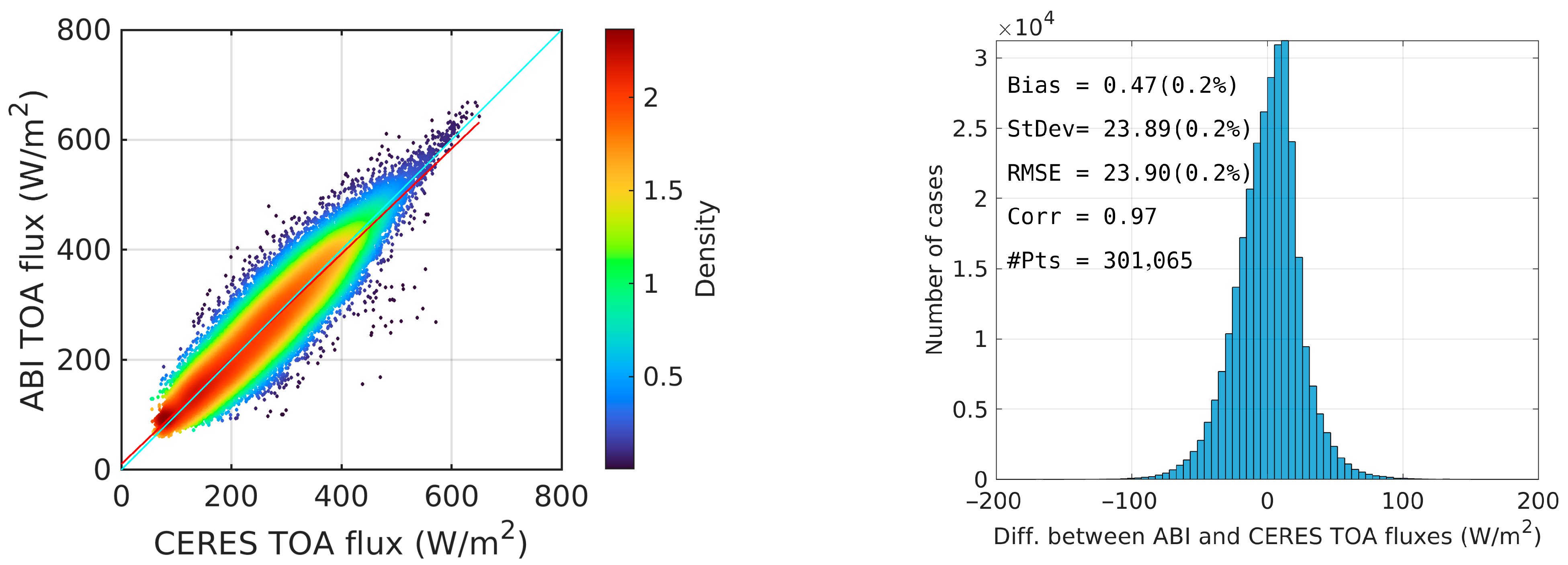


References
- Heidinger, A.K.; Pavolonis, M.J.; Calvert, C.; Hoffman, J.; Nebuda, S.; Straka, W.; Walther, A.; Wanzong, S. Chapter 6—ABI Cloud Products from the GOES-R Series. In The GOES-R Series; Goodman, S.J., Schmit, T.J., Daniels, J., Redmon, R.J., Eds.; Elsevier: Amsterdam, The Netherlands, 2020; pp. 43–62. [Google Scholar] [CrossRef]
- Laszlo, I.; Liu, H.; Kim, H.-Y.; Pinker, R.T. GOES-R Advanced Baseline Imager (ABI) Algorithm Theoretical Basis Document (ATBD) for Downward Shortwave Radiation (Surface), and Reflected Shortwave Radiation (TOA), Version 3.1. 2018. Available online: https://www.goes-r.gov/resources/docs.html (accessed on 10 August 2025).
- Laszlo, I.; Liu, H.; Kim, H.-Y.; Pinker, R.T. Shortwave Radiation from ABI on the GOES-R Series. In The GOES-R Series; Goodman, S.J., Schmit, T.J., Daniels, J., Redmon, R.J., Eds.; Elsevier: Amsterdam, The Netherlands, 2020; pp. 179–191. [Google Scholar] [CrossRef]
- Pinker, R.T.; Ma, Y.; Chen, W.; Laszlo, I.; Liu, H.; Kim, H.-K.; Daniels, J. Top of the Atmosphere Reflected Shortwave Radiative Fluxes from GOES R. Atmos. Meas. Tech. 2022, 15, 5077–5094. [Google Scholar] [CrossRef]
- Berk, A.; Bernstein, L.S.; Anderson, G.P.; Acharya, P.K.; Robertson, D.C.; Chetwynd, J.H.; Adler-Golden, S.M. MODTRAN Cloud and Multiple Scattering Upgrades with Application to AVIRIS. Remote Sens. Environ. 1998, 65, 367–375. [Google Scholar] [CrossRef]
- Hansen, M.C.; Defries, R.S.; Townshend, J.R.G.; Sohlberg, R. Global land cover classification at 1 km spatial resolution using a classification tree approach. Int. J. Remote Sens. 2010, 21, 1331–1364. [Google Scholar] [CrossRef]
- Loeb, N.G.; Smith, N.M.; Kato, S.; Miller, W.F.; Gupta, S.K.; Minnis, P.; Wielicki, B.A. Angular Distribution Models for Top-of Atmosphere Radiative Flux Estimation from the Mission Satellite, Part I: Methodology. J. Appl. Meteorol. 2003, 42, 240–265. [Google Scholar] [CrossRef]
- Niu, X.; Pinker, R.T. Revisiting satellite radiative flux computations at the top of the atmosphere. Int. J. Remote Sens. 2011, 35, 1383–1399. [Google Scholar] [CrossRef]
- Loveland, T.R.; Reed, B.C.; Brown, J.F.; Ohlen, D.O.; Zhu, Z.; Yang, L.; Merchant, J.W. Development of a global land cover characteristics database and IGBP DISCover from 1 km AVHRR data. Int. J. Remote Sens. 2010, 21, 1303–1330. [Google Scholar] [CrossRef]
- Su, W.; Corbett, J.; Eitzen, Z.; Liang, L. Next-generation angular distribution models for top-of-atmosphere radiative flux calculation from CERES instruments: Methodology, 2015. Atmos. Meas. Tech. 2015, 8, 611–632. [Google Scholar] [CrossRef]
- Su, W.; Corbett, J.; Eitzen, Z.; Liang, L. Next-generation angular distribution models for top-of-atmosphere radiative flux calculation from CERES instruments: Validation, 2015. Atmos. Meas. Tech. 2015, 8, 3297–3313. [Google Scholar] [CrossRef]
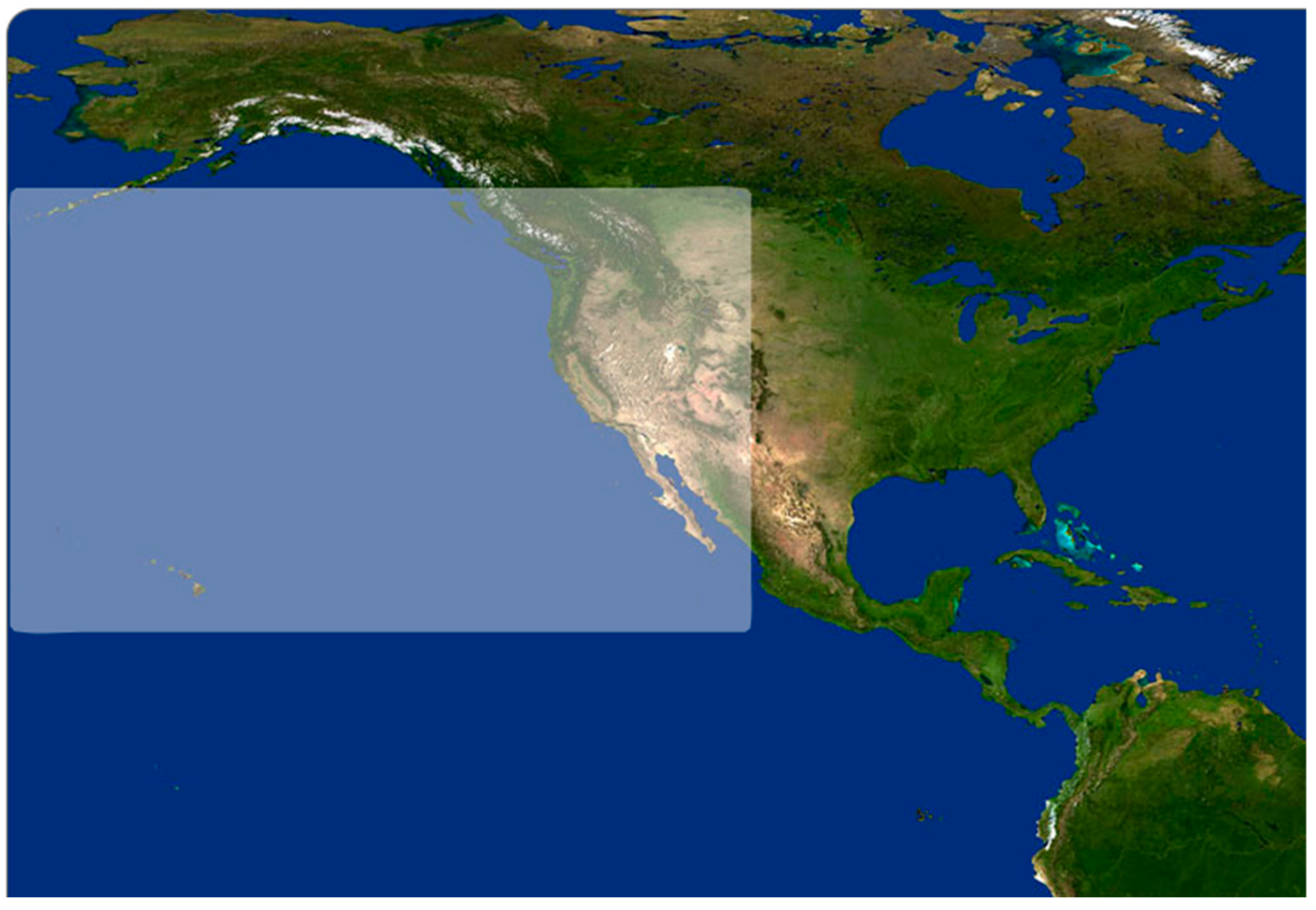

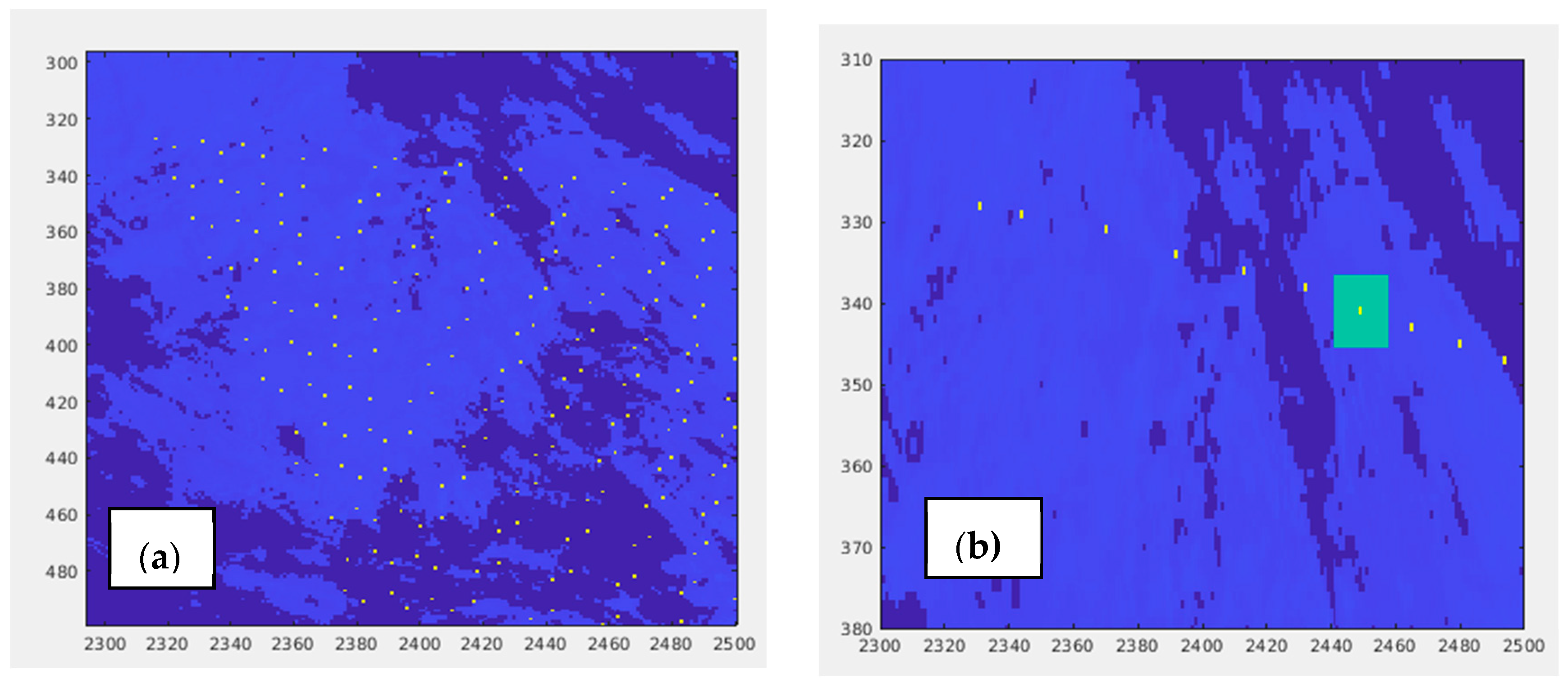
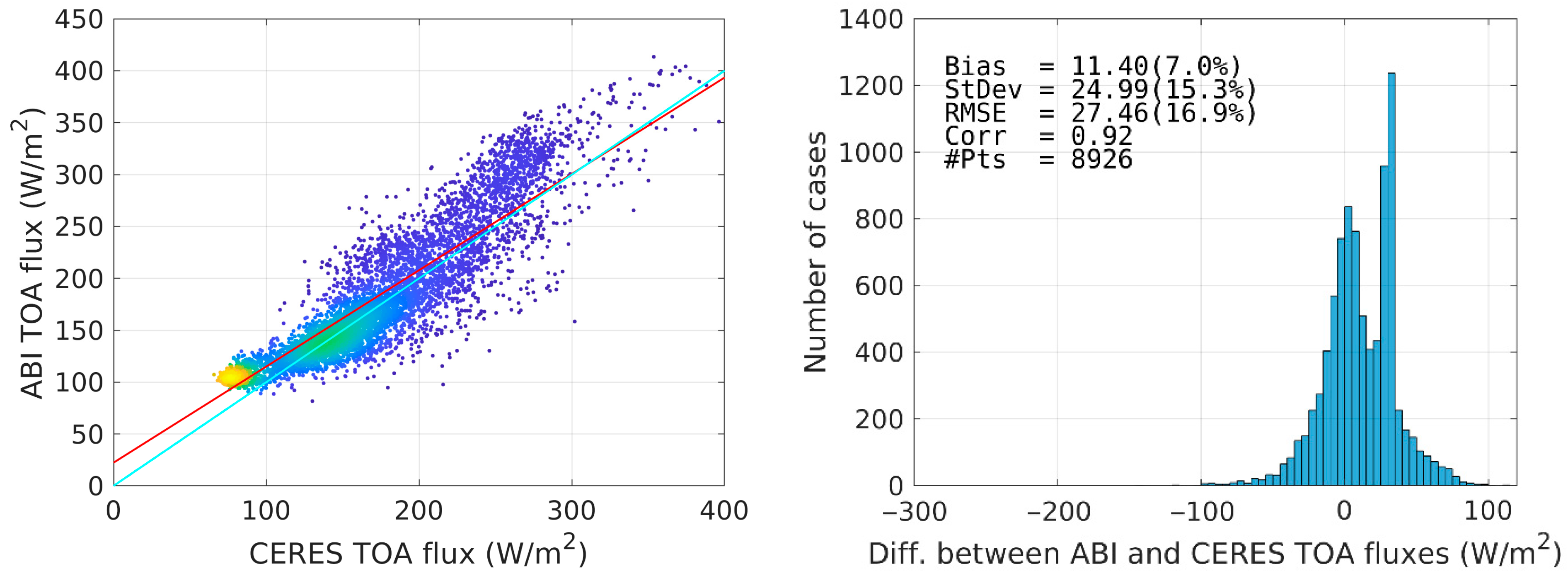
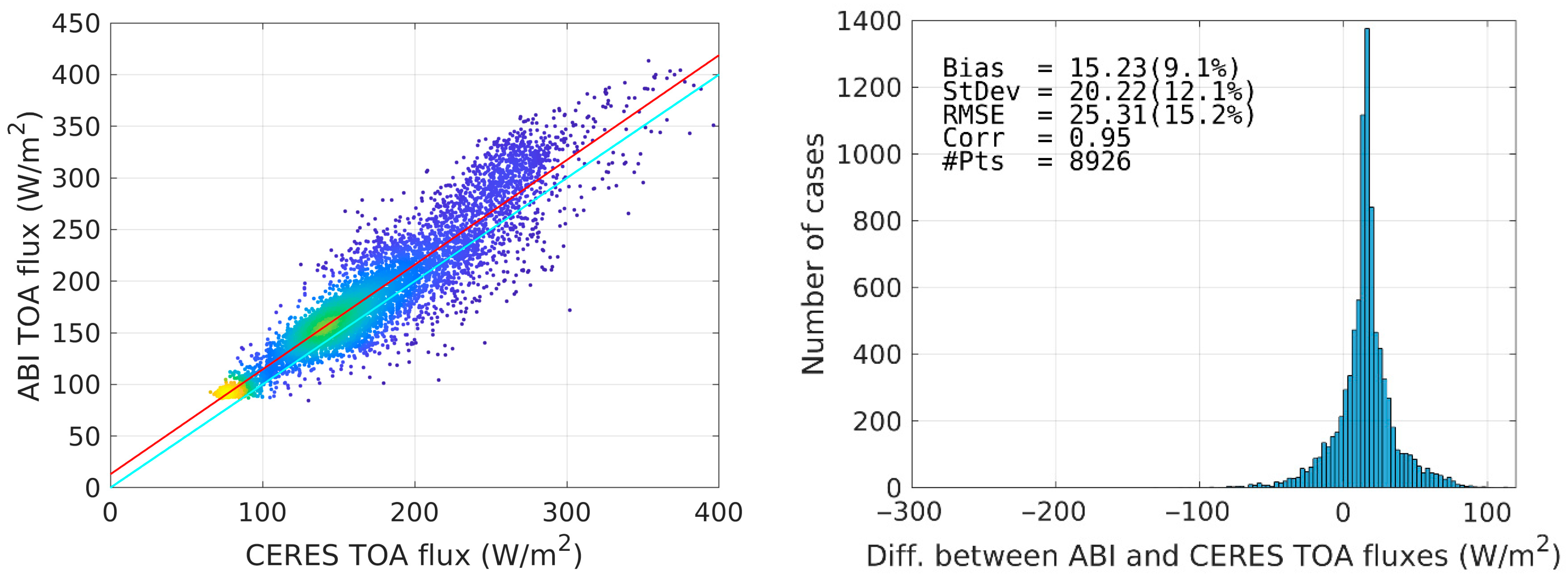
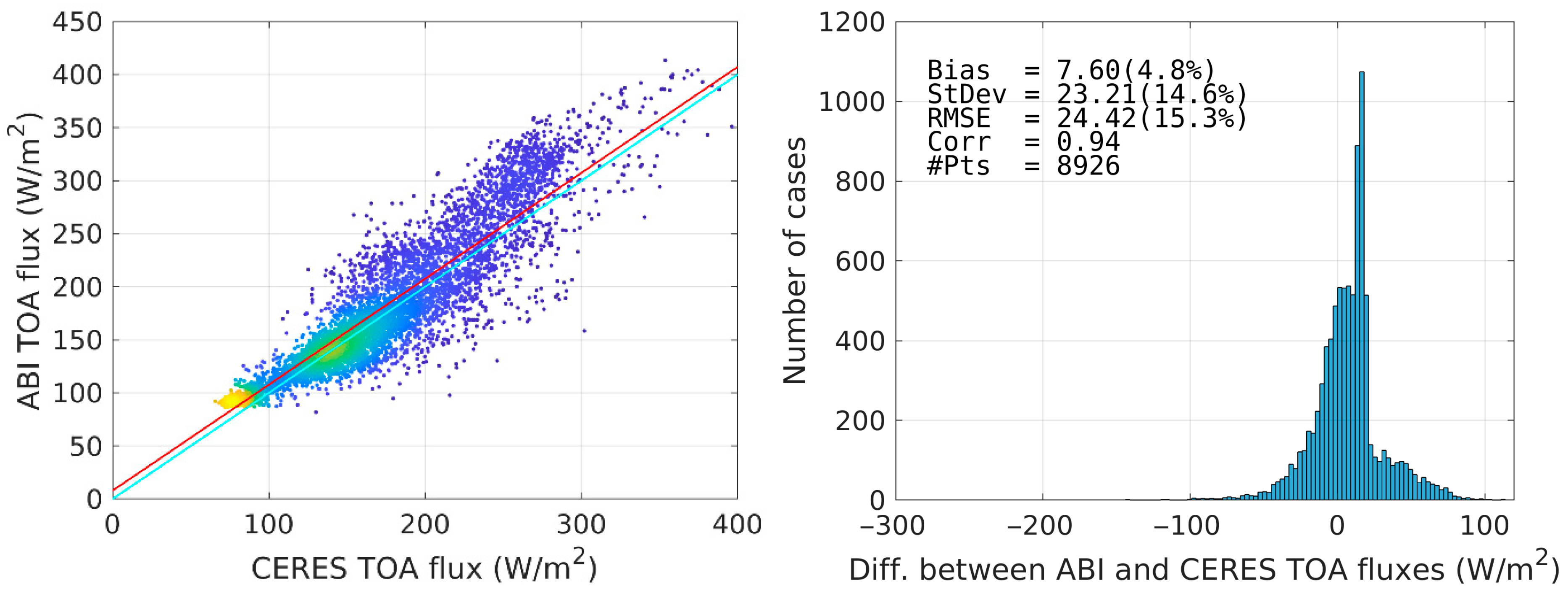
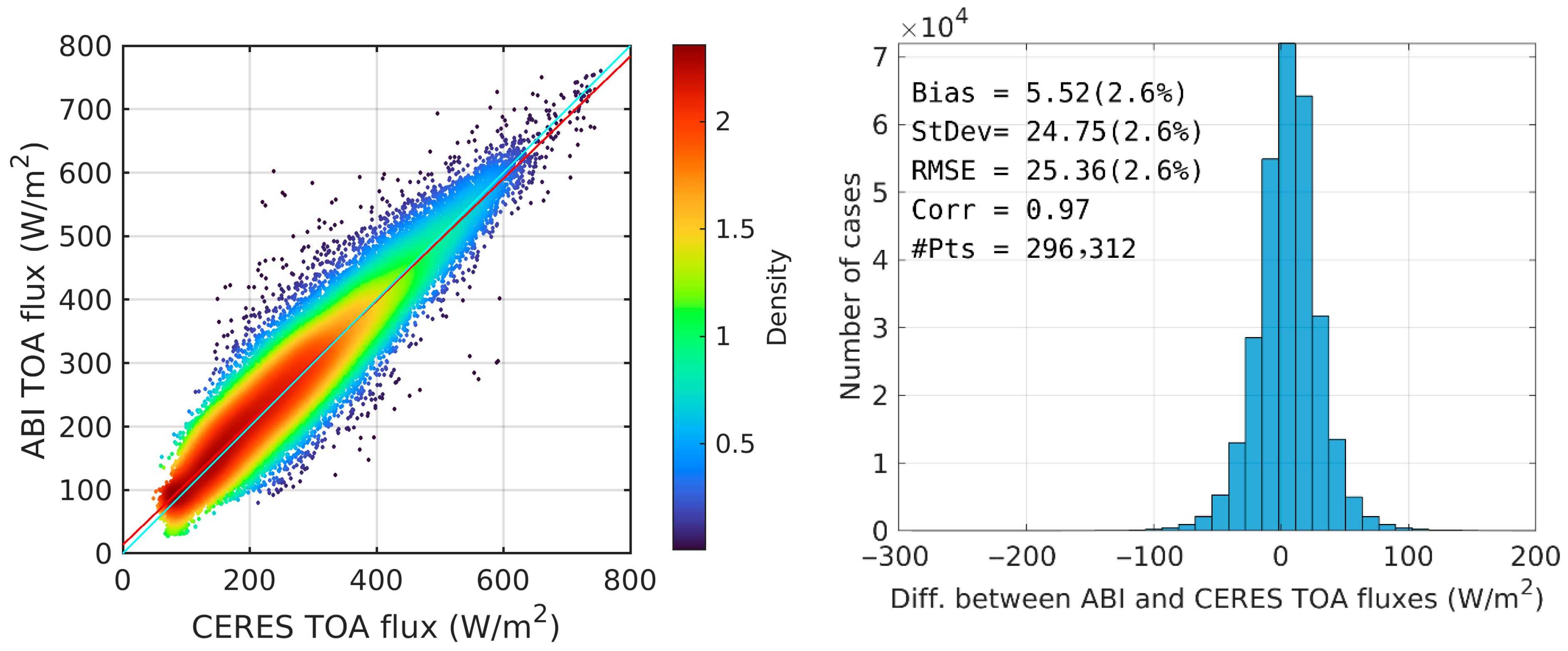
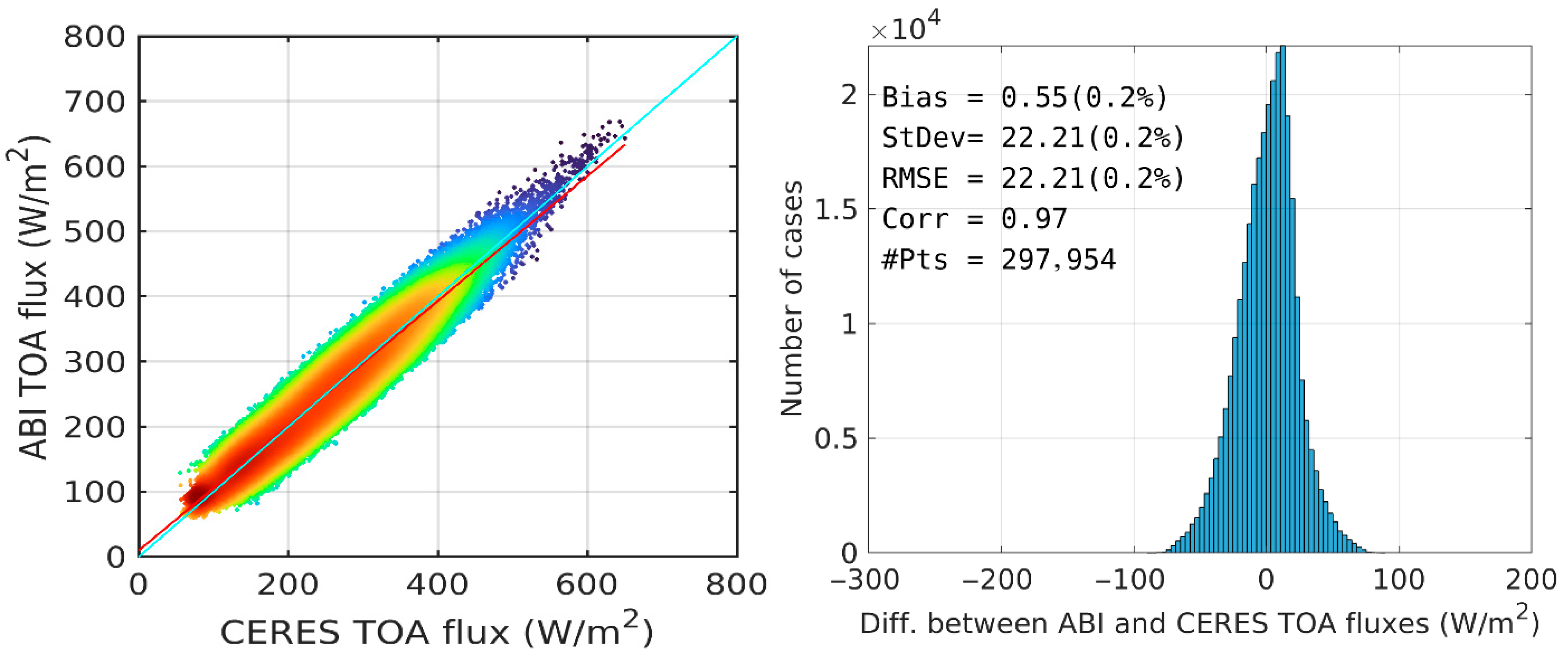
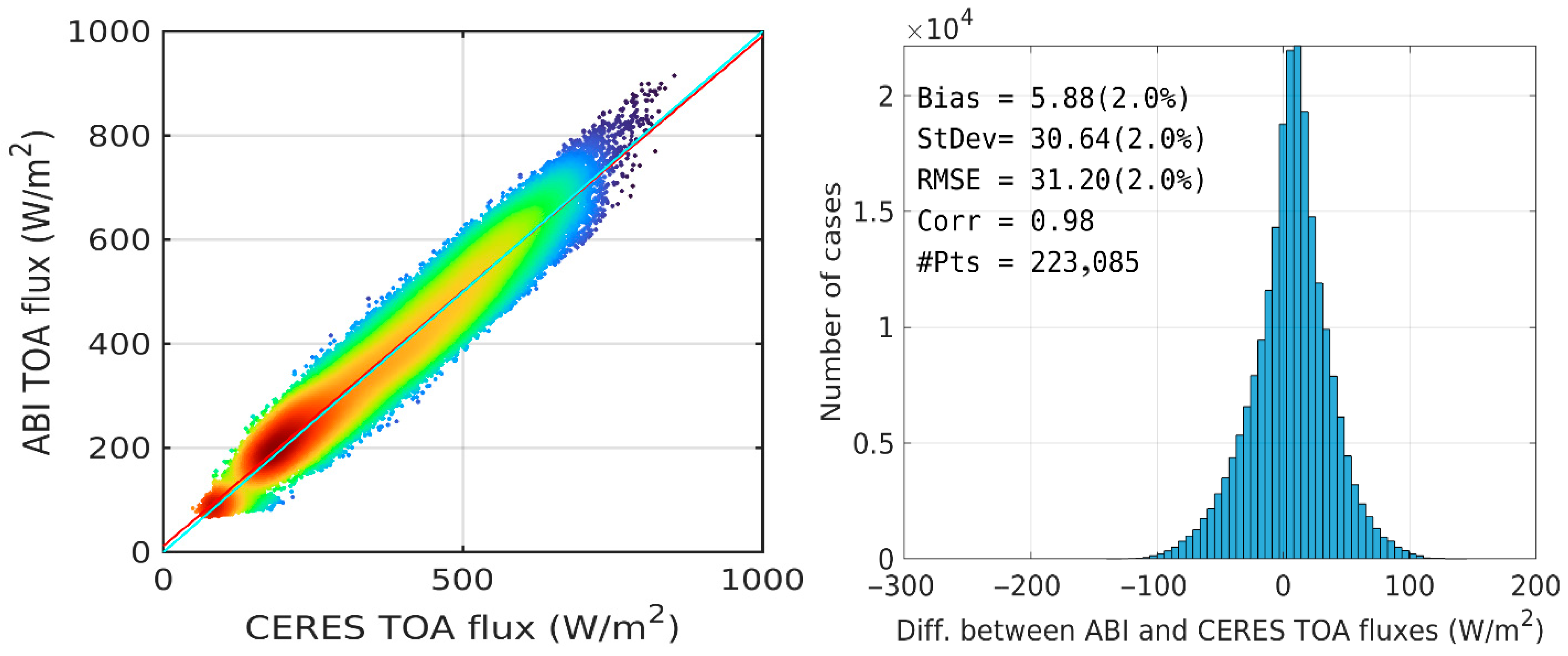
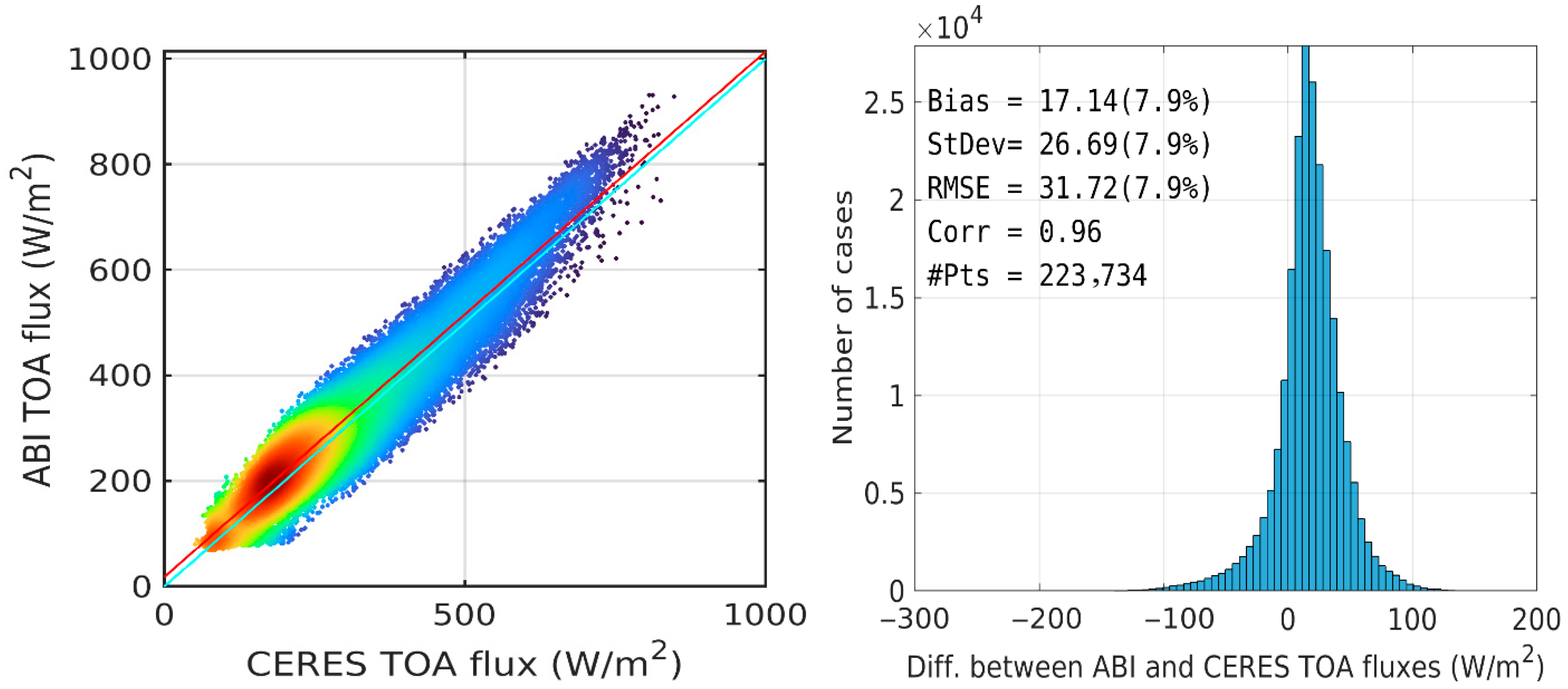
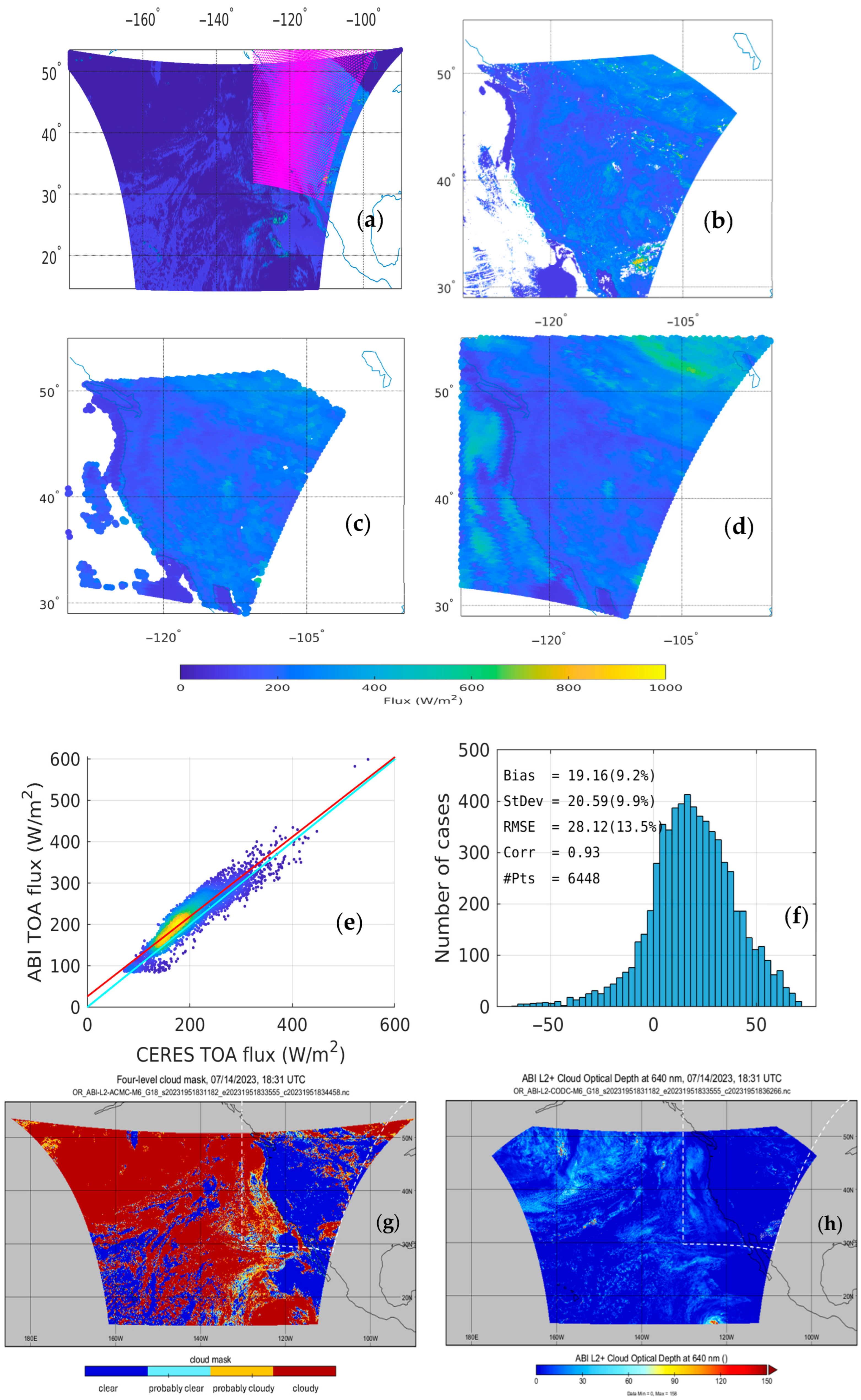
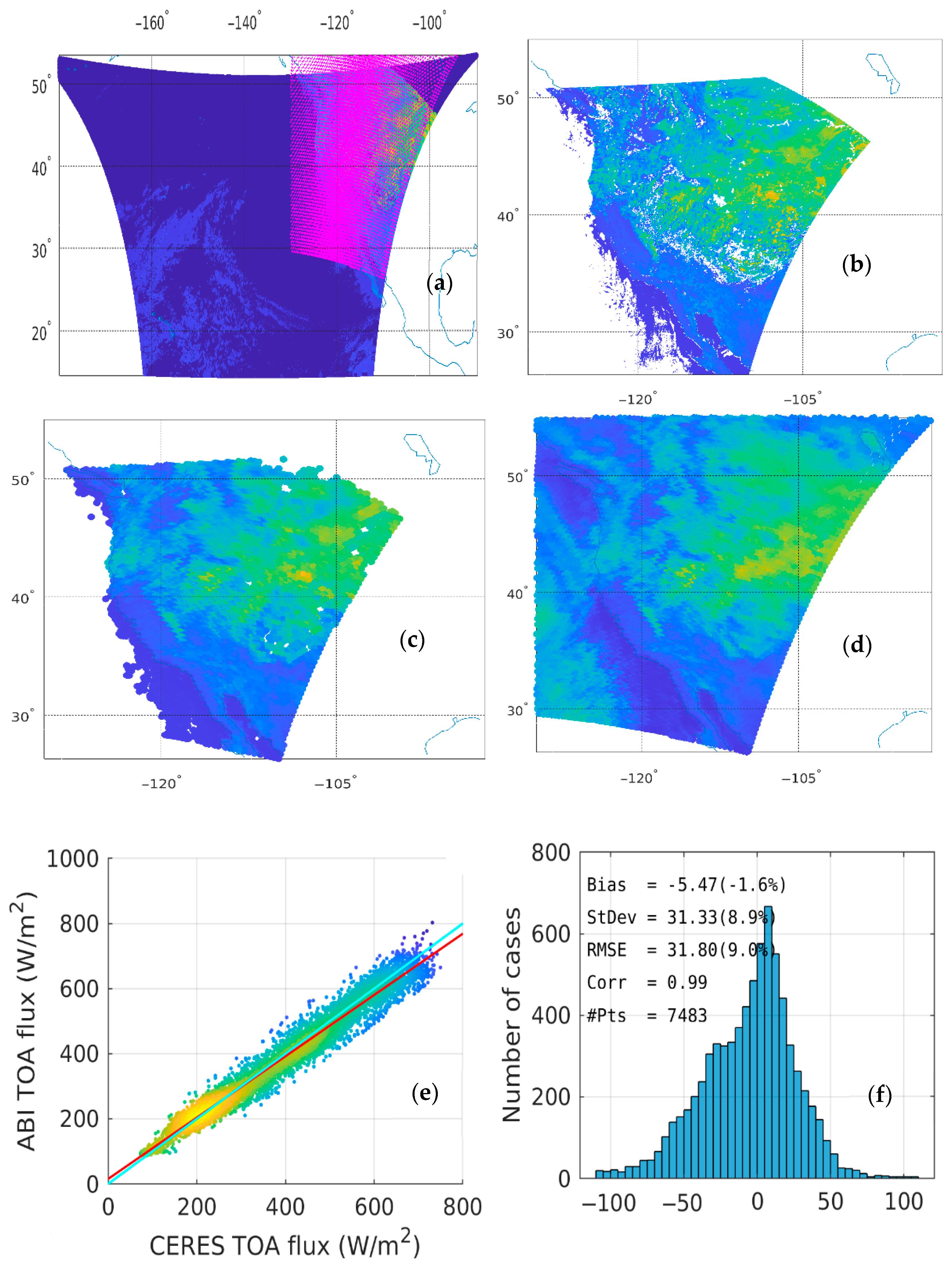
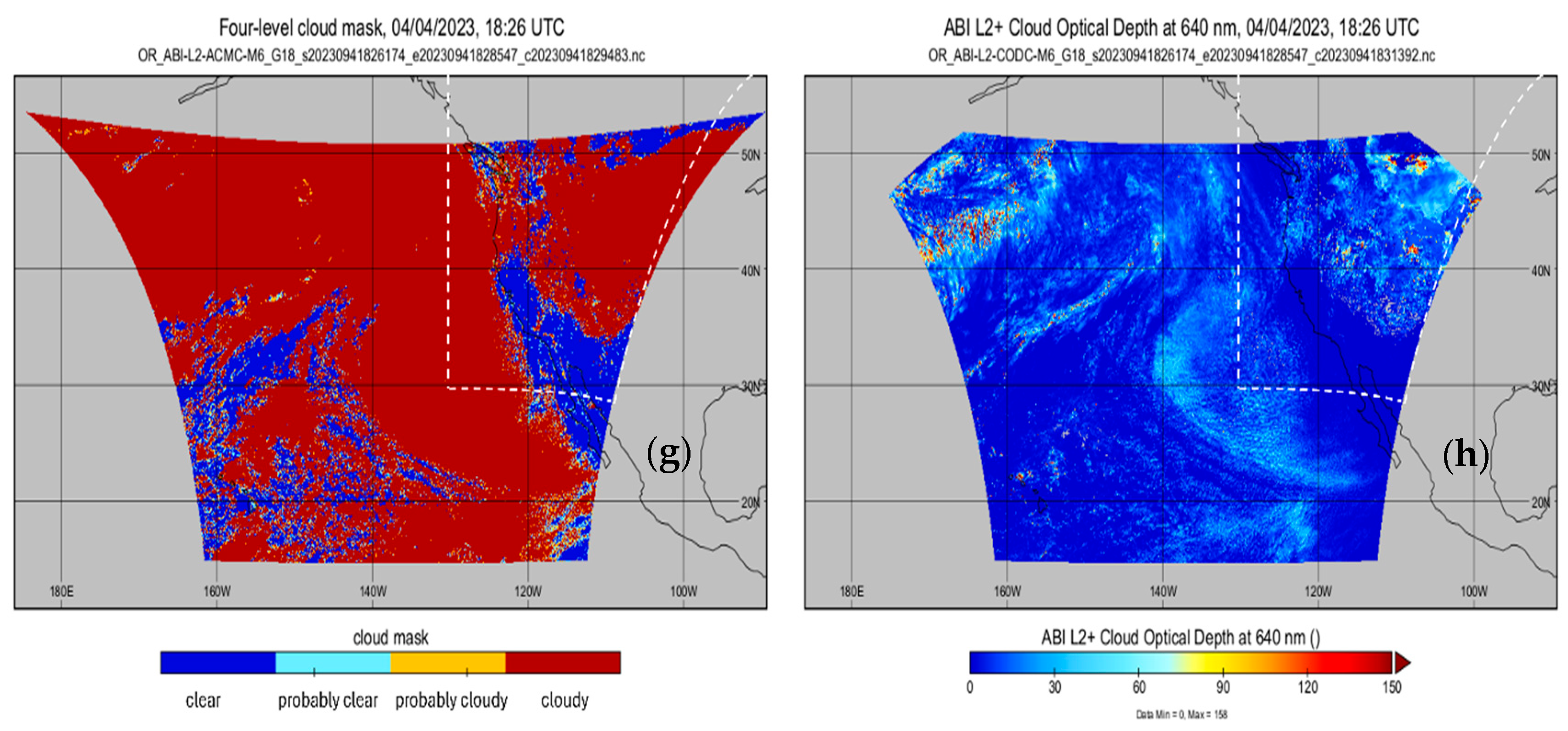
| ABI Band | Central Wavelength (μm) | Type | Best spatial Resolution (km) |
|---|---|---|---|
| 1 | 0.47 | Visible | 1 |
| 2 | 0.64 | Visible | 0.5 |
| 3 | 0.86 | Near-IR | 1 |
| 4 | 1.37 | Near-IR | 2 |
| 5 | 1.6 | Near-IR | 1 |
| 6 | 2.2 | Near-IR | 2 |
| # of Overlap Pixels | CERES/Terra | CERES/Aqua |
|---|---|---|
| >500 | 128 | 78 |
| >1000 | 121 | 72 |
| >5000 | 87 | 43 |
| >10,000 | 47 | 21 |
| >12,000 | 36 | 16 |
| >15,000 | 13 | 7 |
Disclaimer/Publisher’s Note: The statements, opinions and data contained in all publications are solely those of the individual author(s) and contributor(s) and not of MDPI and/or the editor(s). MDPI and/or the editor(s) disclaim responsibility for any injury to people or property resulting from any ideas, methods, instructions or products referred to in the content. |
© 2025 by the authors. Licensee MDPI, Basel, Switzerland. This article is an open access article distributed under the terms and conditions of the Creative Commons Attribution (CC BY) license (https://creativecommons.org/licenses/by/4.0/).
Share and Cite
Ma, Y.; Pinker, R.T.; Chen, W.; Laszlo, I.; Kim, H.-Y.; Liu, H.; Daniels, J. Top of the Atmosphere Reflected Shortwave Radiative Fluxes from ABI on GOES-18. Atmosphere 2025, 16, 979. https://doi.org/10.3390/atmos16080979
Ma Y, Pinker RT, Chen W, Laszlo I, Kim H-Y, Liu H, Daniels J. Top of the Atmosphere Reflected Shortwave Radiative Fluxes from ABI on GOES-18. Atmosphere. 2025; 16(8):979. https://doi.org/10.3390/atmos16080979
Chicago/Turabian StyleMa, Yingtao, Rachel T. Pinker, Wen Chen, Istvan Laszlo, Hye-Yun Kim, Hongqing Liu, and Jaime Daniels. 2025. "Top of the Atmosphere Reflected Shortwave Radiative Fluxes from ABI on GOES-18" Atmosphere 16, no. 8: 979. https://doi.org/10.3390/atmos16080979
APA StyleMa, Y., Pinker, R. T., Chen, W., Laszlo, I., Kim, H.-Y., Liu, H., & Daniels, J. (2025). Top of the Atmosphere Reflected Shortwave Radiative Fluxes from ABI on GOES-18. Atmosphere, 16(8), 979. https://doi.org/10.3390/atmos16080979






